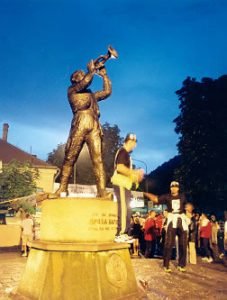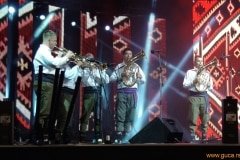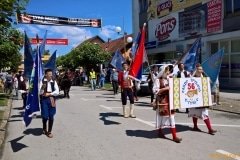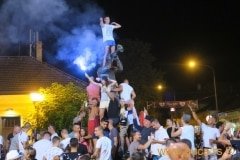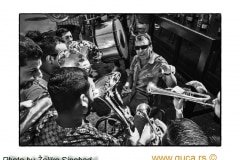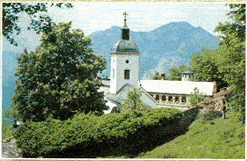Guca Trumpet Festival – Serbia 2026
Background & History
The Guca Trumpet Festival, officially the Dragačevski Sabor (Dragačevo Assembly of Trumpet Players), is the world’s largest brass band festival, held annually in Guča, a serene village of 1,700 residents in Serbia’s Dragačevo region, 150 km south of Belgrade. Launched on October 16, 1961, in the churchyard of Sts. Michael and Gabriel, it was sparked by journalist Blagoje Radivojević of Politika newspaper, inspired by a poignant brass band farewell at Čačak’s railway station for departing soldiers. Initially a modest extension of the “Dragačevo through Song and Dance” festival, it featured four orchestras, with Desimir Perišić, dubbed “Dragačevo’s Harry James,” winning the first competition. His 3-meter statue now stands at Guča’s roundabout, a pilgrimage site for music lovers. The trumpet’s cultural roots trace to 1831, when Prince Miloš Obrenović formed Serbia’s first military band, integrating European brass with Balkan rhythms. By the late 19th century, trumpets were central to rural life, accompanying births, baptisms, weddings, harvests, funerals, and military farewells.
Three distinct regional styles emerged: eastern (Zaječar, melancholic and intricate), southern (Vranje, lively čoček-driven), and western (Užice-Čačak, upbeat kolo rhythms). From 50,000 visitors in 1963, the festival exploded to a record 700,000 in 2010, hosting 3,000+ musicians from Serbia, the Balkans, and countries like Mexico, Denmark, China, and Australia. As a UNESCO intangible cultural heritage candidate, it blends traditional folk with modern ethno-fusion and jazz, featuring icons like Goran Bregović, Boban Marković, Emir Kusturica, and Fejat Sejdić. Jazz legend Miles Davis, a visitor in the 1980s, famously remarked, “I didn’t know you could play trumpet that way,” cementing its global prestige. The festival’s growth mirrors Serbia’s cultural resilience, surviving political upheavals like the Yugoslav breakup. The 2026 edition, its 65th, will emphasize youth orchestras, international collaborations, and eco-friendly practices, contributing €10–€15 million to the local economy and supporting 500+ jobs in Guča and nearby Čačak. With 50+ nationalities attending, partnerships with Serbian Railways, Belgrade Airport, and global media (e.g., Die Zeit, Dreh Punkt Kultur), and a digital reach of 1 million+ via livestreams, Guča is a global cultural beacon, often dubbed the “Serbian Woodstock” for its raw, communal energy.
Date & Duration
Festival Dates
- 2026 Dates: Friday, August 7 – Sunday, August 9, 2026 (main events); full festivities span August 4–10, including pre-festival parades, markets, and local feasts.
- Future Dates: August 6–8, 2027 (estimated, typically the first full weekend of August).
Duration
- 3 days of core events (competitions, concerts, parades); 7 days of broader festivities, encompassing 450+ events across 10+ venues, expecting 300,000–500,000 attendees.
- The festival runs from 11:00 AM to 2:00 AM daily, with street performances, markets, and workshops extending the vibrant atmosphere. Over 3,000 musicians perform, drawing crowds for 20+ hours of daily programming.
Opening Hours
- Main Events: 11:00 AM–2:00 AM (gates open 10:00 AM for stadium and squares).
- Competitions/Concerts: 6:00 PM–midnight at the stadium; street performances 10:00 AM–10:00 PM across Guča’s squares.
- Trumpet Museum: 10:00 AM–6:00 PM (entry ~€3, August 4–10).
- Street of Old Crafts/Book Fair: 12:30 PM–8:00 PM (August 7–9, Branka V. Radičević Square).
- Info Desks: 9:00 AM–11:00 PM at Trg Slobode; call center (+381 65 339 2303) operates December 2025–August 2026 (9:00 AM–5:00 PM).
- Campsites: Open August 3 (noon) to August 11 (noon), with 24/7 security and amenities.
Main Location Addresses
Primary Venues
Guča’s compact, walkable layout transforms its historic core into a festival hub, hosting 300,000+ visitors across multiple venues:
- Stadium (Ulica Vojvode Stepe): Hosts the Golden Trumpet competition, major concerts, and closing ceremony, with a capacity of 5,000, LED screens, PRM platforms, and 20+ food stalls.
- Trg Slobode: Central square for free brass band performances, kolo dances, and costume contests, accommodating 10,000+ spectators.
- Branka V. Radičević Square: Home to the Street of Old Crafts, book fair, and art exhibitions, with 30+ artisan stalls and pop-up stages.
- Cultural Center (Ulica Branka Radičevića): Venue for youth competitions, indoor concerts, and cultural talks, capacity 1,000, with air-conditioned facilities.
- Piazza Ottinetti: Stage for international brass acts and dance groups, featuring pop-up bars and capacity for 5,000.
- Piazza Freguglia: Base for local orchestras and food markets, with space for 5,000 attendees.
- Ponte Borghetto: Route for the traditional wedding parade and spontaneous brass performances, lined with historic bridges.
- Trumpet Museum (Ulica Svetog Save): Showcases 19th-century trumpets and festival history, capacity 200, with daily workshops. Venues are equipped with safety barriers, medical posts, free WiFi, and eco-friendly amenities like solar-powered lighting and recycling stations. Livestreams on guca.rs reach 100,000+ global viewers.
Location Addresses
- Festival Office: Jurija Gagarina 235, 11070 Belgrade, Serbia – Google Maps
- Stadium: Ulica Vojvode Stepe, 36210 Guča, Serbia – Google Maps
- Trg Slobode: Trg Slobode, 36210 Guča, Serbia – Google Maps
- Cultural Center: Ulica Branka Radičevića, 36210 Guča, Serbia – Google Maps
- Trumpet Museum: Ulica Svetog Save, 36210 Guča, Serbia – Google Maps
- Piazza Ottinetti: Piazza Ottinetti, 36210 Guča, Serbia – Google Maps
- Piazza Freguglia: Piazza Freguglia, 36210 Guča, Serbia – Google Maps
- Ponte Borghetto: Ponte Borghetto, 36210 Guča, Serbia – Google Maps
Cultural Experience
Artistic Diversity
The Guca Trumpet Festival is a vibrant celebration of Balkan brass, featuring 3,000+ musicians across 20+ orchestras performing traditional Serbian kolo, čoček, and march tunes, infused with Gypsy, Ottoman, and jazz influences. Headliners like Boban Marković, Coby, and Bojan Ristić blend folk with modern ethno-fusion, drawing 10,000+ to nightly concerts. Theatre includes reenactments of Dragačevo weddings, with actors in period costumes (šajkača hats, embroidered vests) performing alongside brass bands. Dance groups, such as KUD Abrašević Guča, compete in kolo and oro dances (August 8, 4:00 PM), judged for precision and cultural authenticity. The Trumpet Museum hosts daily talks on brass evolution, while street poets recite epic Serbian ballads, attracting 500+ listeners daily. Art exhibitions, featuring photographers like Elvis Bajramović (2025 showcase), and 30+ local painters display festival-inspired works, blending traditional and contemporary styles.
Community Engagement
Guča’s 1,700 residents swell to host 300,000 visitors, with locals joining orchestras, volunteering as guides (500+ volunteers), and opening homes for accommodation. Free street events, including kolo dances and costume contests, engage all ages, while 1,000+ students from Čačak schools participate in youth competitions, fostering future talent. The festival app enables “People’s Choice” voting, with 5,000+ votes cast in 2025, and the hashtag #Guca2026 connects 1 million+ global fans on social media. Partnerships with Čačak schools fund music programs (€10,000/year), and UNESCO candidacy events (August 7, 2:00 PM) promote cultural preservation through talks and exhibitions. The festival’s economic impact supports 500+ local jobs, from food vendors to transport services, and community feasts like fagioli grassi strengthen bonds.
Culinary and Local Traditions
Food stalls (50+) across Trg Slobode and Piazza Ottinetti serve Serbian and Balkan specialties, reflecting Dragačevo’s culinary heritage:
- Savory: Ćevapi (grilled sausages with ajvar, ~€6–€10), pljeskavica (beef patty with kajmak, ~€8–€12), sarma (cabbage rolls, ~€7–€11), roasted lamb (~€10–€14).
- Vegetarian/Vegan: Polenta with cheese, grilled peppers, djuvec rice (~€7–€11).
- Desserts: Baklava, tufahija (stuffed apples), knedle (plum dumplings), štrudla (~€3–€7).
- Drinks: Rakija (plum or quince brandy), Moravian wine, Pilsner, Knjaz Miloš (~€3–€8); non-alcoholic kvas, elderflower juice (~€2–€5).
- Bean Feasts (August 8, 9:00 AM): Fagioli grassi (beans with pork, ~€5) in Trg Slobode symbolize community unity, serving 2,000+ portions. Markets sell handmade šajkača hats (~€10), rakija bottles (~€15), and embroidered vests (~€20), preserving local crafts.
Local Exploration
Guča’s rural charm and proximity to cultural and natural sites enhance the festival experience:
- Trumpet Monument/Museum: Central Guča, ~€3 entry, 200 daily visitors, showcasing 19th-century trumpets and festival archives.
- Ovčar-Kablar Monasteries (15 km): 10 medieval Orthodox monasteries, guided tours (~€5, 1 hr) explore 14th-century frescoes.
- Rzav River (20 km): Rafting, kayaking (~€30–€50), and scenic picnics, bookable via info@guca.rs.
- Zlatibor Mountain (50 km): Hiking, skiing, farm stays (~€20/night), with trails and panoramic views.
- Sargan Eight Railway (75 km): Historic narrow-gauge train ride through Mokra Gora (~€75, 2.5 hr), a UNESCO candidate.
- Čačak National Museum (20 km): Exhibits on Dragačevo history, artifacts (~€4).
- Morava River (20 km): Fishing permits (~€10), ideal for relaxation.
- Kraljevo (40 km): Žiča Monastery, 13th-century coronation site (~€5).
Food & Drinks
Culinary Offerings
- Savory: Ćevapi (10 sausages with ajvar, ~€6–€10), pljeskavica with kajmak (~€8–€12), sarma (~€7–€11), roasted lamb, goulash (~€10–€14).
- Vegetarian/Vegan: Polenta with cheese, grilled peppers, djuvec rice, stuffed zucchini (~€7–€11).
- Desserts: Baklava, tufahija, knedle with plums, apple štrudla (~€3–€7).
- Beverages: Rakija (plum, quince, apricot), Moravian wine, Pilsner, Knjaz Miloš (~€3–€8); non-alcoholic kvas, elderflower juice, šljivovica cordial (~€2–€5).
Dining Logistics
- 50+ stalls across Trg Slobode, Piazza Ottinetti, and near the stadium, open 10:00 AM–10:00 PM.
- Payment: Cash (RSD/EUR), credit/debit cards at main stalls.
- Allergen info displayed; vegan/gluten-free options marked at 20+ stalls.
- Free water stations near venues; non-metallic bottles allowed.
- Biodegradable packaging and recycling bins reduce waste by 15% since 2023.
Getting There
By Air
- Belgrade Nikola Tesla Airport (BEG): 150 km (~2 hr drive, flights ~€100–€300 USD from Europe). Shuttles to Guča (~€15–€25, 2.5 hr, book via info@guca.rs).
- Kragujevac Airport: 60 km (~1 hr, limited flights, ~€80–€200 USD).
- Niš Airport: 200 km (~3 hr, ~€100–€250 USD), with bus connections (~€20).
By Train
- Čačak Station: 20 km from Guča; trains from Belgrade (~2 hr, ~€10–€15, 6 daily). Taxis to Guča (~€10, 20 min).
- Serbian Railways: Book at zeltur.rs; group discounts (~10%).
By Bus
- From Belgrade: 3 hr, ~€10–€20 (BAS station, 10 daily departures, book via info@guca.rs).
- From Čačak: 30 min, ~€2, hourly buses.
- From Kraljevo: 1 hr, ~€5, 5 daily.
By Car
- From Belgrade: A2 highway, 150 km (~2.5 hr). Parking €5–€10/day near stadium; caravan sites €20/day (200 spaces).
- From Čačak: Route 179, 20 km (~25 min).
- From Kraljevo: 40 km (~45 min).
By Bike/Walking
- Bike rentals in Guča (~€10/day, book via info@guca.rs), with 10 km of trails.
- Village walkable; venues 5–10 min apart on foot.
Accessibility
Overview
The festival adheres to basic Serbian accessibility standards, with improvements planned for 2026. Contact info@guca.rs for PRM support (48 hr response, multilingual).
Accessible Tickets
- Free for disabled with valid ID; companion passes available via info@guca.rs.
- Discounts: 10% for seniors (65+), students with ID (~€5.50 for concerts).
- Priority seating for PRM in stadium (50 seats).
Venue Accessibility
- Ramps at stadium, Cultural Center, and Trg Slobode for wheelchair access.
- PRM viewing platforms in Trg Slobode, Piazza Ottinetti (capacity 50 each).
- Accessible toilets (5) near stadium, Piazza Freguglia, and Cultural Center.
- Induction loops in Cultural Center for hearing-impaired visitors.
Transport Accessibility
- PRM parking (€5/day, 100 spaces) near stadium, pre-book via info@guca.rs.
- Accessible buses from Belgrade/Čačak (~€15, 2–3 hr, book 72 hr in advance).
- Taxis with ramps from Čačak (~€10, pre-book via info@guca.rs).
Digital Accessibility
- Website guca.rs partially WCAG-compliant, with alt-text for images.
- Festival app (TBD 2026) will include voice navigation and high-contrast mode.
- Social media updates (#Guca2026) in English/Serbian with captions for videos.
On-Site Support
- Medical posts (3 locations, 10:00 AM–midnight) with paramedics and first aid.
- Multilingual stewards (English, Serbian, French) at all venues.
- Service dogs permitted with ID; no pets allowed.
Maps
Video
FAQ's
When is the Guca Trumpet Festival 2026?
August 7–9, 2026 (main events); full festivities August 4–10. Events 11:00 AM–2:00 AM. Program at guca.rs.
How do I buy tickets?
Stadium concerts RSD 800 (~€6.50) at guca.rs or on-site (August 7–9, 10:00 AM–7:00 PM). Accommodation €105/3 nights via info@guca.rs. Street events free.
What accessibility options are available?
Ramps, PRM platforms, accessible toilets. Free tickets for disabled; companion passes via info@guca.rs. Service dogs allowed; medical posts on-site. Contact +381 65 339 2303.
How can I get to Guča?
Air: Belgrade Airport (150 km, ~€100–€300 USD); shuttles ~€15. Train/Bus: Belgrade to Čačak (~€10–€20, 3 hr); Čačak to Guča (~€2, 30 min). Car: A2 from Belgrade (2.5 hr); parking €5–€10/day. Details at guca.rs.
What’s the 2026 program?
Opening August 7 (11:00 AM, Trumpet Monument); Golden Trumpet competition August 9 (6:00 PM); international concerts August 7–8 (8:30 PM). Wedding parade August 9 (1:00 PM). Closing August 9 (10:45 PM). Lineup TBA March 2026 at guca.rs.

